Cultural fair brings old crafts back to daily life
The curtains rose at the 10th Cross-Straits Folk Culture Fair in Fuzhou, Fujian province on Feb 9, which displayed a line of eye-opening ancient handicrafts.
The exuberant cultural fair was launched in the city's Huahai Park, as the subtropical coastal city enjoys a warm early February, with the air suffused with the tweeting of birds and the aromas of spring flowers.
All these provided a festive atmosphere for visitors to join the two-day event that presented ingenious craftsmanship in various forms, as well as fascinating folk performances, intriguing lantern riddles, and chances to sample local tea and traditional snacks.
Rice gain sculptures
Creating intricate artworks from grains of rice has been practiced by artists in Gaolou village for some 300 years, but after 70 years of neglect the few remaining masters of this art form are now in their 80s or 90s, putting the handicraft under the threat of extinction.
Fortunately, thanks to the instruction from these old masters, a young man called Chen Guorui has learned the skill and is giving the art form a new lease of life. To welcome the Year of the Rooster, Chen spent 18 days making a statue of a rooster without any historical works to use for reference.
After finishing this challenging work, Chen started considering how to prolong the lifetime of a rice threads work.
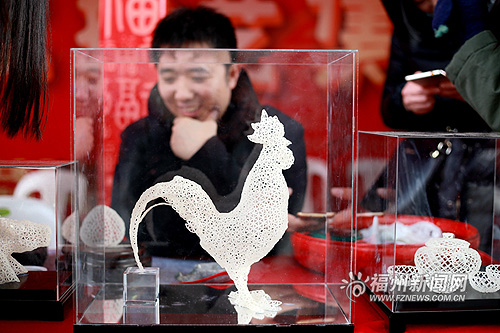
An exquisitely crafted rooster sculpture made from rice gains is on display the 10th Cross-Straits Folk Culture Festival in Fuzhou, Fujian province on Feb 9. The work was created by the young artisan Chen Guorui, who has given a new lease of life to the neglected art form.[Photo/fznews.com]
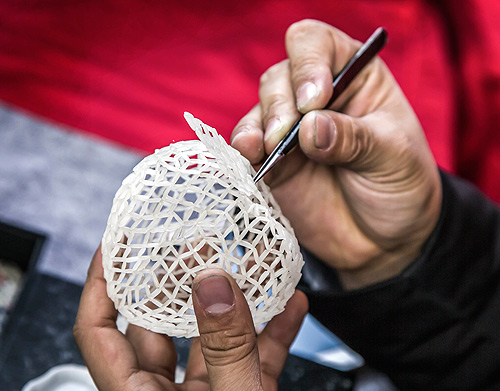
Chen works on a peach-shaped rice sculpture. [Photo/asiannewsphoto]

Chen Guorui explains how he creates rice gain art the 10th Cross-Straits Folk Culture Festival in Fuzhou, Fujian province on Feb 9. [Photo/fjsen.com]
.jpg)
A tea set made from rice gains is on display the 10th Cross-Straits Folk Culture Festival in Fuzhou, Fujian province on Feb 9. [Photo/fznews.com]
Coir raincoat
A signature image in Chinese poetry when it depicts a misty rainy day, coir raincoats are one of the brilliant Chinese inventions from ancient times. Made from web-like fibers peeled from palm bark, the coat is weaved layer upon layer like a piece of armor. People still wear the coats today in some regions in China.
Wu Xungui, a 50-year-old resident of Dongqiao, is now the only person left in his hometown who practices this ancient craft.
The raincoat on display at the cultural fair took Wu three days to make, and is reminiscent of those bygone days.

Wu shows a visitor a photo he took of her trying on a coir raincoat the 10th Cross-Straits Folk Culture Festival in Fuzhou, Fujian province on Feb 9. [Photo/fznews.com]
Lacquer thread sculpture
Originating in Quanzhou city, Fujian's unique, delicate lacquer thread sculpture art evolved from ancient techniques used to decorate Buddha statues dating back to the Tang Dynasty (AD 618-907). Lacquer threat sculpture eventually developed into its own form around the turn of the Ming and Qing dynasties (1368-1644, 1644-1912).
Producing a lacquer thread work is an intricate process requiring delicacy at every step, from making the paste wax, rubbing the lacquer thread into varied forms, to twisting the lacquer threads into elaborate patterns and finally covering it with gold foil.
This demanding craft requires great patience, but the end result is dazzling.
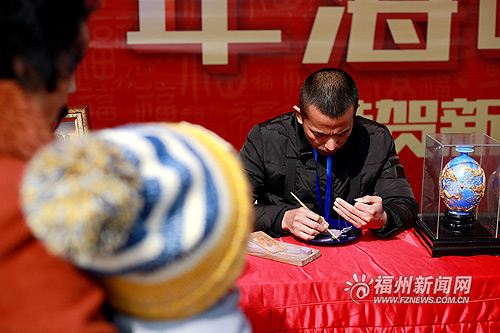
Artist Lan Quancheng demonstrates the process of intertwining fine lacquer threads into lifelike sculptures at the 10th Cross-Straits Folk Culture Festival in Fuzhou, Fujian province on Feb 9. [Photo/fznews.com]
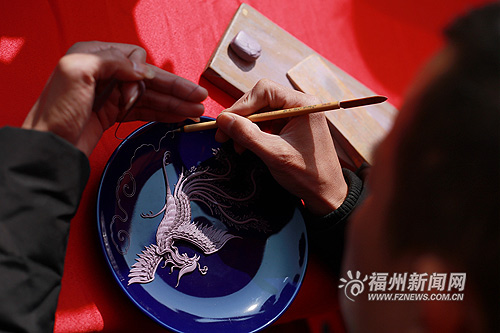
Artist Lan Quancheng demonstrates the process of intertwining fine lacquer threads into lifelike sculptures at the 10th Cross-Straits Folk Culture Festival in Fuzhou, Fujian province on Feb 9. [Photo/fznews.com]
She textiles
Clad in traditional costumes, two women of the She ethnic minority from Luoyuan county, one of the areas in China with the highest populations of She people, showed visitors how to fabricate colorful cloth with tools made from timber and bamboo.
She people’s traditional attire is made from homemade ramie cloth, and is embellished with geometrical patterns and laces featuring birds and flowers. The most renowned example of She clothes making is the fenghuang zhuang, or phoenix costume, a beautiful traditional outfit usually worn by She women during important festivals. The phoenix costume was added to China’s national list of intangible cultural heritage in 2008.
However, this handicraft is under threat as few people are planting ramie, the raw material used to make the homespun cloth. Nowadays, only a handful of people wear traditional She attire, and only on special occasions.
The locals are now pinning their hope for a renaissance of the dressmaking art on tourism, according to Zhong Caitong, a male of She ethnic group.
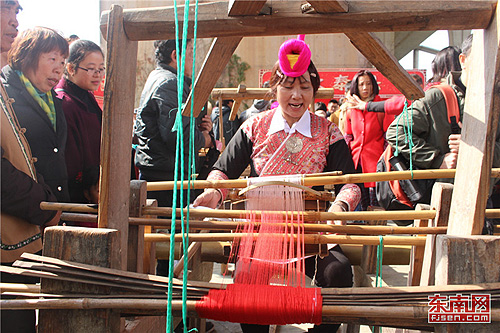
A woman of the She ethnic minority from Luoyuan county weaves cloth at the 10th Cross-Straits Folk Culture Festival in Fuzhou, Fujian province on Feb 9. [Photo/fjsen.com]
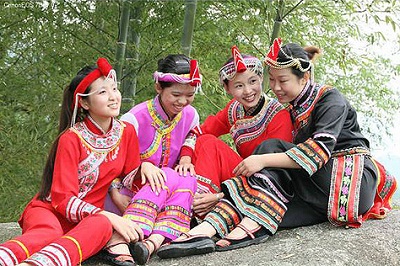
A group of She women model traditional phoenix outfits, complete with florid headwear and intricate embroidery, the most famous kind of attire worn by people of the She ethnic minority. [File photo/culture.china.com]
Vine weaving
Made of wild grape vines, Yongtai county’s weaving products exhibit an interesting and valuable aging effect. The items become more attractive as their colors deepen over time, explained Zhang Qingming, curator of Yongtai’s exhibition area at the festival.
Zhang has been promoting the craft as a brand, applying for trademarks and registering two patents. And the products have won favor in the Japanese market with choice pieces sold at up to 46,000 yuan ($6,700). Zhang also brought quality products to show at the fair, where one handmade bag was tagged at nearly 9,000 yuan.
The prices are reasonable given that grape vines growing in the wild are not easy to gather, and that now, as with many other traditional crafts, the weaving art faces a problem of a lack of talented practitioners, according to Zhang.
Zhang’s effort did not come to nothing. The enduring charm of the artifacts caught the discerning eyes of international luxury brands, some of which have expressed interest in cooperating with him.

A handmade vine-weaved bag for sale at the 10th Cross-Straits Folk Culture Festival in Fuzhou, Fujian province on Feb 9. [Photo/fjsen.com]
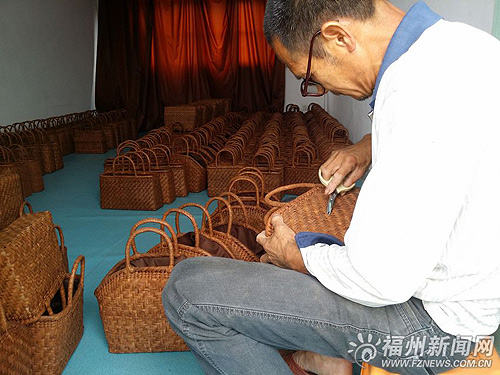
An artisan crafts a vine-weaved bag at the 10th Cross-Straits Folk Culture Festival in Fuzhou, Fujian province on Feb 9. [File photo/fznews.com]

A root carving figure from Minhou county is on display at the 10th Cross-Straits Folk Culture Festival in Fuzhou, Fujian province on Feb 9. [Photo/fjsen.com]

An elderly woman smiles as she receives a rooster-shaped sugar figurine at the 10th Cross-Straits Folk CultureFestival in Fuzhou, Fujian province on Feb 9. [Photo/fznews.com]

Visitors try to crack lantern riddles at the 10th Cross-Straits Folk Culturea Festival in Fuzhou, Fujian province on Feb 9. [Photo/fjsen.com]
-
Previous:none
-
Next:
This article has no related articles!






